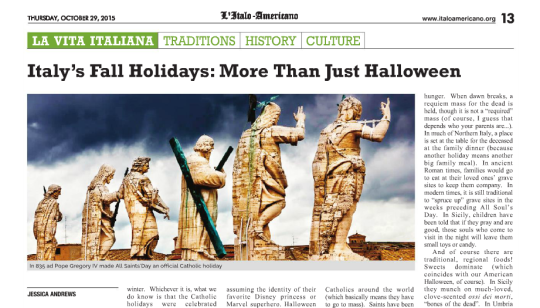This article was originally posted in the October 29th, 2015 edition of L’Italo-Americano Newspaper, a great resource (written in both English and Italian!) for current Italian news and cultural discussion. Be sure to subscribe to the digital or print edition on their site!

Slowly but surely, the US & UK secular traditions of trick-or-treating and costume parties on October 31st are starting to permeate Italy’s larger cities. Here in Milan, I’ve seen plastic pumpkins and jack-o-lanterns, nylon spider webs, witches hats and glow-in-the-dark ghosts in stores for the past month. Even here, though, in Italy’s arguably most “international” city, Halloween isn’t as widely celebrated as it is back home. I know a few schoolchildren who will go trick-or-treating within their buildings or small communities, but their costumes will consist of only a mask or hat, maybe some face-paint. They won’t be dressed head-to-toe in expensive or elaborate costumes, assuming the identity of their favorite Disney princess or Marvel superhero. Halloween parties, on the other hand, are for adults. A friend of mine and her husband spent a Halloween in the States a few years ago and ever since then they have invited friends over on Halloween night to carve pumpkins. Others, though, have less “G-rated” parties at high-end bars or private residences. You can definitely feel the presence of Halloween here, but just as a random fun thing to do, like the antique market or Star Wars Day (which was celebrated in Milan’s historic arena in a BIG WAY on May 4th).
The real holiday – the official state holiday, in fact – is All Saint’s Day, La Festa di Ognissanti, on November 1st. This is a day honoring all of the Catholic saints and is a holy day of obligation for practicing Catholics around the world (which basically means they have to go to mass). Saints have been worshipped in the Christian faith from the early days of its formation, but it wasn’t until 835ad that Pope Gregory IV made All Saints’ Day an official Catholic holiday. It’s celebrated as most Catholic holidays are celebrated in Italy: by going to church and sitting down to a large and long family meal.
That night, in some parts of the country, families may set out a glass of water, food or a lantern in preparation for All Souls’ Day, I Giorni dei Morti, on November 2nd. It is (traditionally) believed that on this day, families can be visited by their dearly departed loved ones. They leave out a lantern in some regions to help the dead find their way home, water so the dead can quench their thirst and a bit of bread so they can stifle their hunger. When dawn breaks, a requiem mass for the dead is held, though it is not a “required” mass (of course, I guess that depends who your parents are…). In much of Northern Italy, a place is set at the table for the deceased at the family dinner (because another holiday means another big family meal). In ancient Roman times, families would go to eat at their loved ones’ grave sites to keep them company. In modern times, it is still traditional to “spruce up” grave sites in the weeks preceding All Soul’s Day. In Sicily, children have been told that if they pray and are good, those souls who come to visit in the night will leave them small toys or candy.
And of course there are traditional, regional foods! Sweets dominate (which coincides with our American Halloween, of course). In Sicily they munch on much-loved, clove-scented ossi dei morti, “bones of the dead”. In Umbria they’re a little less gruesome, instead simply eating sweet, almond-flavored fave dei morti, “beans of the dead” and sweets made with quince apple jelly. Campagna, instead, prepares a chocolate and almond desert called torrone dei morti, and the delights go on and on.
All Souls’ Day became a holiday upon the recommendation of Abbot Odilo of Cluny in 998ad, who believed that the dearly departed who needed prayers and God’s grace to make it out of purgatory into heaven should be celebrated on the day after we commemorate the Saints, who have already found peace in heaven. The Catholic Church later followed the abbot’s advice.
How will you celebrate these three days of holidays this year? What traditions will you keep?
Comments
comments










Leave a Reply